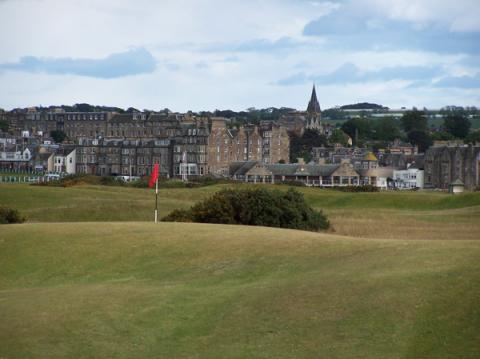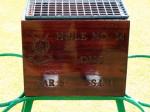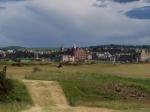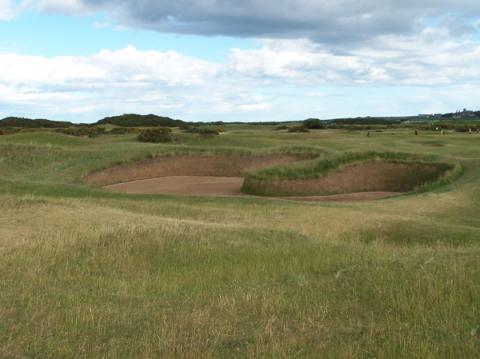
Damned if you do: Those who steer clear of Hell bunker and play down the right side of #14 at the Old Course will be faced with an approach over a large hump that guards the right front of the green.
Par 5 odyssey features heaven, Hell and a little Kitchen
The way American golf holes are rated tends to be annoying and a little insulting to decent golfers. Par 5s too often receive the #1 handicap hole designation no matter how mild the challenge. On some courses, you know that one or two of the par 3s are tougher than the par 5s. But length appears to equate to difficulty for those who rate golf courses, probably because most golfers have trouble putting three straight shots together.
The Scots have more respect for their golfers, and on courses I played in Scotland recently, the toughest hole is as likely to be a par 4 as it is a par 5. At Scotscraig Golf Club in Tayport, the 4th hole, called Westward Ho, measures just 366 from the tips but is the #1 "stroke index" hole. At the seaside Crail Balcomie Links, the long par 4 5th, the aptly named Hell's Hole, plays around the shoreline and into the prevailing winds and rates toughest at 447 yards from the tips. The three par 5s at Crail are rated the 5th, 10th and 14th most difficult on the course.
Perhaps their par 5s play shorter than American fives because of longer rolls on links fairways. Or maybe the Scots hit the ball straighter than Americans do, having had a few hundred years more practice. But straight is not at all helpful at the toughest hole at St. Andrews' Old Course, the par 5 14th called simply Long. The Old Course yardage book calls it the "model for strategic golf holes the world over." I call it beautifully brutal.
The middle of the three tees on #14 plays from 523 yards, and the strategy depends entirely on how the wind is blowing off the nearby Firth. If you are able to ignore the Siren call of the cityscape beyond the green and hit the ball 210 yards into the wind, the play is down the left, over the group of four bunkers called the Beardies, to an area of fairway aptly named the Elysian Fields. In mythology, Elysium is the eternal resting place of the virtuous and the heroic. I don't know how virtue plays into the tee shot at #14, except in regards to patience, but heroic effort certainly comes into play if the wind is blowing. (And how often does it not blow at St. Andrews?) The less adventurous will find ample fairway to the right of Elysium, but a wall with out of bound beyond it runs down the entire right side of the fairway, making placement there almost as scary as the Beardies.
If you negotiate the tee shot properly and make it to the Elysian Fields, the next play is a lay-up of 170 to 190 yards to a small area to the left of one of the most famous bunkers in the world, the Hell bunker, placed front and center on the path to the green. It is large, it is arced and shaped in such a way as to maximize the potential for a lie under the perfectly vertical and sodded front edges, and it is strangely beautiful. For those shy about risking Hell, laying up short of the bunker is not much of an option since the tiny but deadly Kitchen bunker guards Hell. I have not been able to find the derivation of the name Kitchen, but Cerberus would be a more apt name for this little devil.
and center on the path to the green. It is large, it is arced and shaped in such a way as to maximize the potential for a lie under the perfectly vertical and sodded front edges, and it is strangely beautiful. For those shy about risking Hell, laying up short of the bunker is not much of an option since the tiny but deadly Kitchen bunker guards Hell. I have not been able to find the derivation of the name Kitchen, but Cerberus would be a more apt name for this little devil.
Those with no pretense of heroics can play short and right of the Hell bunker, but that leaves a 160-yard approach to the green over a large hump that guards the front right. Land on either side of the hump and the ball will skitter away from the green. Land over the hump and chances are good the ball will roll off the back of the firm and sloped green. In short, the chance of getting within easy two-putt range will be remote if you approach from the right side of the fairway.
Okay, let's say you make it safely to the area just left of Hell, leaving about 125 yards into the largest green you have ever played (the 14th green combines with the 4th). You are now faced with an all-carry shot over two menacing pot bunkers called Ginger Beer (each appearing to be about the size of a bottle of ginger beer). The green is elevated and, of course, firm; the approach must be short in order to roll on and have a chance of staying on the putting surface. If you have made it there in three shots, you have an excellent shot at par or even birdie -- assuming you haven't pulled the ball onto the 4th green and left yourself a putt of 50 yards.
you have ever played (the 14th green combines with the 4th). You are now faced with an all-carry shot over two menacing pot bunkers called Ginger Beer (each appearing to be about the size of a bottle of ginger beer). The green is elevated and, of course, firm; the approach must be short in order to roll on and have a chance of staying on the putting surface. If you have made it there in three shots, you have an excellent shot at par or even birdie -- assuming you haven't pulled the ball onto the 4th green and left yourself a putt of 50 yards.
Welcome home, Odysseus.

A play off the tee at #14 to the Elysian Fields at the Old Course will leave you with a lay-up to the left of the other-worldly Hell bunker.























